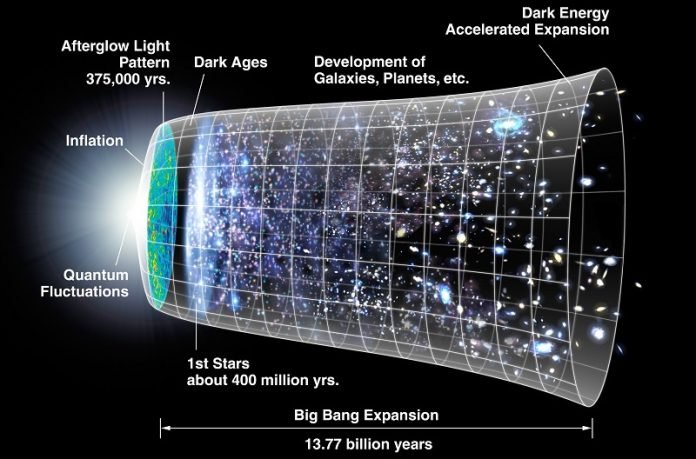
In 1916, Einstein finished his Theory of General Relativity, which describes how gravitational forces alter the curvature of spacetime.
Among other things, this theory predicted that the Universe is expanding, which was confirmed by the observations of Edwin Hubble in 1929. Since then, astronomers have looked farther into space (and hence, back in time) to measure how fast the Universe is expanding – aka. the Hubble Constant.
These measurements have become increasingly accurate thanks to the discovery of the Cosmic Microwave Background (CMB) and observatories like the Hubble Space Telescope.
Astronomers have traditionally done this in two ways: directly measuring it locally (using variable stars and supernovae) and indirectly based on redshift measurements of the CMB and cosmological models.
Unfortunately, these two methods have produced different values over the past decade. As a result, astronomers have been looking for a possible solution to this problem, known as the “Hubble Tension.”
According to a new paper by a team of astrophysicists, the existence of “Early Dark Energy” may be the solution cosmologists have been looking for.
The study was conducted by Marc Kamionkowski, the William R. Kenan, a junior professor of physics and astronomy at Johns Hopkins University (JHU), and Adam G. Riess – an astrophysicist and Bloomberg Distinguished Professor at JHU and the Space Telescope Science Institute (STScI).
Their paper, titled “The Hubble Tension and Early Dark Energy,” is being reviewed for publication in the Annual Review of Nuclear and Particle Science (ARNP). As they explain in their paper, there are two methods for measuring cosmic expansion.
The direct method involves using supernovae as “standard candles” (distance markers) to conduct measurements on the local scale. The indirect method involves comparing measurements of the CMB with cosmological models – like the Lambda Cold Dark Matter (LCMD) model, which includes the presence of Dark Matter and Dark Energy.
Unfortunately, these two methods produce different results, the former yielding a value of ~73 km/s per megaparsec (Mpc) and the latter yielding ~67 km/s Mpc. As Dr. Reiss broke it down to Universe Today via email:
“The Hubble constant is the present rate at which the Universe expands.
The Hubble tension is a discrepancy in the value you find for the Hubble constant when you either measure the expansion rate as best you can at present or you predict the value it should have based on the way the Universe looked after the Big Bang coupled with a model of how the Universe should evolve.
Its a problem because if these two ways do not agree, it makes us think we are misunderstanding something about the Universe.”
But as Reiss adds, the mystery of the Hubble Tension is not as much of a problem as it is an opportunity for new discovery.
So far, many candidates have been offered to explain the discrepancy, ranging from the existence of extra radiation, modified General Relativity (GR), Modified Newtonian Dynamics (MOND), primordial magnetic fields, or the existence of Dark Matter and Dark Energy during the early Universe that behaved in different ways.
These can generally be divided into two categories: early-time (shortly after the Big Bang) and late-time solutions (more recently in cosmic history).
Late-time solutions postulate that the energy density in the post-recombination Universe – when the ionized plasma of the early Universe gave rise to neutral atoms (ca. 300 000 years after the Big Bang) – is smaller than in the standard LCMB model.
Early-time solutions, meanwhile, postulate that the energy density was somehow increased before recombination occurred so that the “sound horizon” (the comoving distance a sound wave could travel) is decreased. For the sake of their study, Kamionkowski and Kenan considered Early Dark Energy (EDE) as a potential candidate.
As Reiss explained, the presence of EDE would have contributed about 10% of the total energy density of the Universe before recombination occurred. After recombination, the energy density would have decayed faster than other forms of radiation, thus leaving the late evolution of the Universe unchanged.
“It would produce a burst of extra, unexpected expansion in the young Universe that, if we didn’t know about it, would cause the predicted value to underestimate the true value,” said Reiss.
What makes EDE preferable to late-time solutions is how the latter implies the existence of a fluid that effectively creates energy out of nothing – which violates the strong energy condition predicted by GR.
What’s more, such models are difficult to reconcile with the Cosmic Distance Ladder measurements of Cepheid variables and Type Ia supernovae in nearby galaxies (low-redshift targets) and Type Ia supernovae in distant galaxies (high-redshift). In short, solutions that involve modifications to early-Universe dynamics appear to be most consistent with established cosmological constraints.
As they note, while there is a growing body of evidence that hints at the existence of EDE, our current measurements on the CMB are not precise and robust enough yet to distinguish EDE models from the standard LCDM model.
What is needed, moving forward, are improved local measurements that will help refine the Hubble Constant and remove any systematic errors. Second, more precise measurements of CMB polarization on smaller angular scales are needed to test EDE and other new physics models.
As they indicate in their paper, these steps are already being taken thanks to observatories the Dark Energy Survey and next-generation observatories, like the James Webb Space Telescope (JWST) and the ESA’s Euclid mission:
“Fortunately, the next steps in exploring the Hubble tension are clear.
Moreover, the required observational infrastructure is already in place, as it coincides largely with that assembled to study (late-Universe) dark energy and inflation. Ultimately, we must continue to explore astrophysical and measurement uncertainties.
As we have learned over and over in cosmology, there is no single bullet – robust conclusions are only reached with multiple observational avenues and a tightly knit web of calibrations, cross-calibrations, and consistency checks.”
Written by Matt Williams.
Source: Universe Today.



